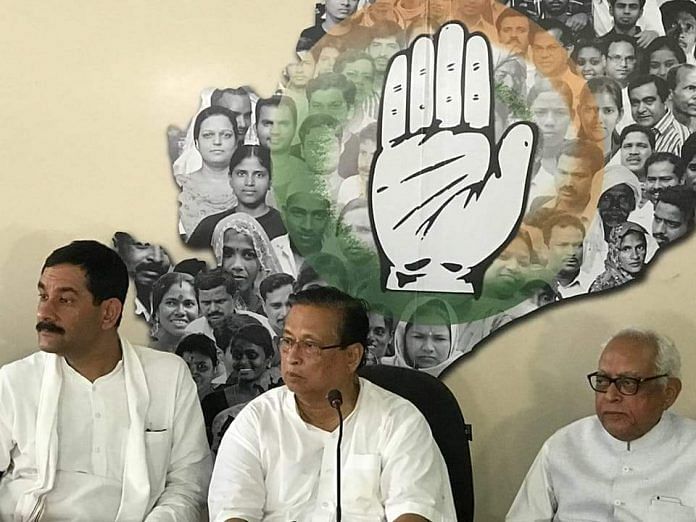State Congress president Niranjan Patnaik lists the challenges his party faces in Odisha, says it’s difficult but not impossible for Congress to dislodge the ruling BJD.
New Delhi: Odisha became a “laboratory” for Congress leaders from New Delhi who never took the state seriously and it did not go down well with the people, Niranjan Patanik, the newly appointed state Congress president, has said.
The grand old party has been out of power in the eastern coastal state since 2000. It is desperately looking to revive its fortunes in next year’s assembly elections that will be held simultaneously with the general elections. It is locked in a triangular contest with the ruling Biju Janata Dal (BJD) and the BJP.
In an interview to ThePrint, Patnaik conceded that it would be “very difficult” for the party to dislodge the BJD from power next year, “but it is possible”.
“Odisha people want change but they don’t find an alternative (in the Congress). If we don’t work hard and don’t remain united, it will be the same,” he said.
Patnaik received a rousing welcome when he landed in Bhubaneswar Saturday. The gathering of an estimated 15,000 people has drawn the attention of the party’s political adversaries and political observers who had written it off, especially after the BJP emerged as the main challenger to Naveen Patnaik’s BJD in the panchayat polls last year.
BJD a formidable force
In 2014, the “Modi wave” failed to have much of an impact in Odisha, once again proving chief minister Naveen Patnaik’s ability to deal with such phenomena. But the Congress’ prolonged inertia and the Centre’s focus on the state seemed to have given the BJP a headstart.
“After the panchayat polls, the BJP was feeling confident but its appeal has been on the wane since then,” said Niranjan Patanik, adding that the youth, the tribals, the Dalits, and the minority communities are “completely frustrated” with the BJD too.
“But the Congress has not taken advantage (of the declining popularity of the BJP). It has gone to the BJD,” he said.
Niranjan Patnaik had been removed as the state Congress chief in 2013, just when the party appeared to be putting up a fight. Violent clashes between Congress workers and the police during a September 2012 rally in Bhubaneshwar had made national headlines.
Factionalism in Congress
Patnaik has been brought back to head the party again, a year before the assembly and parliamentary elections, but the Congress high command has saddled him with three working presidents and heads of important committees. These appointments have been attributed to the high command’s endeavour to satisfy warring factions and bring them together, but the move might undermine the PCC chief in terms of manoeuvring space, some observers said.
“This is the AICC (All India Congress Committee) pattern to appoint working presidents. How could I prevent it? Those who have been appointed are young, energetic and I hope they will deliver,” said Patnaik.
“We made a lot of mistakes in the past and we are still doing it. Odisha became the laboratory for AICC people for long,” he said.
“Odisha was never taken seriously by the national people. That is the inner feeling of the people of Odisha,” said Patnaik, seeking to explain the party’s decline in Odisha.
How Congress mishandled 1999 cyclone
He traced its beginning to the mishandling of the 1999 cyclone by the then Congress government headed by Giridhar Gamang.
The Congress lost the assembly elections held a few months later. Gamang might have caused the downfall of the Congress in Odisha, but before that he was instrumental in bringing down the then Atal Bihari Vajpayee government. He had been chief minister for two months when Vajpayee government moved a confidence motion in the Lok Sabha. Gamang, still a Member of Parliament, flew down to New Delhi to vote against it; the motion was defeated by one vote. Gamang joined the BJP in 2015.
To a query whether the party could project him its chief ministerial candidate, Patnaik said, “I am the face of the party (organisation). My job is to first ensure that the party wins.”
“I am not keen to become chief minister but I want to do something for the people of Odisha,” he added.
A section of political observers believe the BJD is so well-ensconced at present that the next assembly elections could be a fight between the BJP and the Congress for the No. 2 slot. In the 2014 Lok Sabha elections, the Congress had drawn a blank in the state that sends 21MPs to the lower house; the BJD won 20 and the BJP 1.
The numbers game
The Congress has 16 MLAs in the 147-member Odisha assembly; the BJP has 10. The Congress was runner-up in 74 seats and the BJP in 36. In 2014, the Congress’ vote share in the assembly election was 25.7 per cent as against the BJP’s 18 per cent. In the Lok Sabha polls, the shares were 26.4 and 21.9 per cent respectively.
The Congress can’t afford to gloat over its arithmetical superiority to the BJP though. Remember how its vote share in Tripura fell from 36.5 per cent in 2013 to 1.8 per cent in 2018, with the BJP taking away virtually its entire vote base to oust the Left government.
The BJP’s resurgence in Odisha started in a similar fashion with the party emerging second to the BJD in the panchayat polls. Subsequent polls, including the Bijepur assembly bypoll and those for smaller civic bodies in a couple of towns recently, indicate that the saffron party is struggling to hold on to its advantage.
“Everyone knows that Odisha is a tough state but it is possible for the Congress to bring a change,” said Patnaik. “We will work hard to win the confidence of the people of Odisha.”







What Cong needs is to create a Cadre of committed workers, improve mass contact & expose hollow claims of BJP